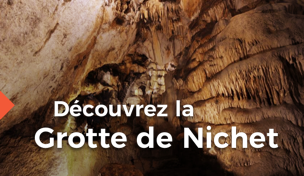A little history

NICHET CAVE
Nichet Cave is the most remarkable element of our municipal heritage.
This unique underground cavity is the only one open to visitors in the north-east of France.
The municipality was aware of its importance and unique nature, and in 1895 they installed basic facilities to enable tourists to come and admire its stalactites, stalagmites and wonderful rock formations.

These facilities and the subsequent digs revealed discoveries of archaeological interest: the remains of animals that have disappeared from our region such as the cave bear, mammoth and reindeer... but also human bones of Homo sapiens and the Merovingians.
Other more recent digs, in 1965, in the vicinity of the cave, revealed a human presence and the most recent, in 1995, led to the discovery of a common grave dating to the Bronze Age and containing the skeletons of 17 people.
Another notable event, from the 17th or 18th century, was the discovery of the skeleton of a man who is said to have hidden in the cave to escape the law and possibly died of hunger and cold.
After the Second World War, the cave was virtually forgotten and it was not until 1987 that the new municipality renovated the installations and made improvements, including stairs, electricity and an audio system... and a reception chalet was built on the site.
The site has changed since then. It now consists of a small reception chalet, a large snack bar chalet, car park, a picnic area, benches, barbecues, a children’s play area, a fitness trail, a bouncy castle and a black pine observatory.
Visiting Nichet Cave:
Nichet Cave is the only underground cavity in the north of France that is open to visitors.
At a depth of 53 metres, it comprises 20 chambers on 3 levels, only ten of which are accessible to the public.
The temperature is a constant 9 degrees Celsius.
During the reign of Louis XIV, the cave was already known to the inhabitants of the village and the surrounding area, but no one dared to venture there because it was believed that Hell was at the centre of the earth and the cave was the entry.

It is only from the beginning of the 19th century that certain people braved the legend and began to venture into the nearest chambers.
The cave was opened to the public for the first time in 1899. It was until the 1950s and was then abandoned for over 30 years because the last war had caused rather serious damage.
After extensive works; which included the installation of lighting, ramps and the sound system, the cave was opened on 11 April 1987 for the delight of tourists.
Numerous archaeological digs in the Abyss and Lion’s chambers led to the discovery of human bones dating from the Neolithic period.
This revealed that prehistoric man lived here 5,000 years ago. The only entrance to the cave for the Neolithic tribes was a natural opening that was created by a collapse, known as an aven.
(Aven: a hole formed in limestone areas).

During your visit, you will see a black film on some walls. This colour is not natural. It was caused by the smoke of the torches and acetylene lamps that the first guides used during their visits.
As you go deeper into the cave, this colour disappears, due first of all to the crumbling of the limestone and also because Nichet cave continues to drain rainwater, little by little restoring the walls to their original colours.
From the Nuton to the Skeleton chambers, passing through the Abyss, Moonlight and Lover’s chambers, legends are intertwined among the stalagmites (upwards) and the stalactites (downwards). A universe at the centre of the Earth with imaginary characters, "The Nutons", the story of a human skeleton... and 114 steps that bring you back to reality.
These few lines are simply an invitation to Fromelennes, near Givet, to visit the Nichet Cave that will lead you from "one surprise to another, from one wonder to the next".
THE OTHER CAVE... TASSON CAVE
Not open to the general public, Tasson Cave is reserved for confirmed cavers.
The cave descends into the Middle Devonian (Givetian sub-system), at a few dozen metres from the exit of Nichet Cave, which can be visited by the general public.
It was discovered in 1950 as a result of the disappearance of a dog belonging to Mr Barbier, one of the cave’s guides, into a cleft known as the Tasson hole (they believed it was just a badgers’ burrow!) that was too narrow to allow a man to enter.
In 1953, cavers cleared the entrance and managed to enter the cave.
The entrance, located at an altitude of 195 m, is a small porch at the bottom right of which there is a very narrow well, 10 metres in depth.
This leads to a small chamber and an inclined gallery whose floor is covered with topsoil from a small, obstructed gallery that leads back to the surface.

This gallery leads to a chamber of 15 x 5 metres, the Well chamber, which is the starting point for:
- a vertical descent of 4 metres and a descending gallery that leads to the Chimney chamber;
- a small cavity: the Macaroni niche;
- a 16-metre well leading to the Mast chamber;
- a horizontal gallery 12 metres in length;
- two ascending chimneys: one of 27 metres, the other of 45.
All these parts are fossilised and allow cavers to descend to a depth of approximately 35 metres.

We are still far from the active network which must be the same as that of the Cave that is open to visitors, and may correspond to the level of the outfall of the Dion-le-Val stream (140 m alt.).
However, there is no known resurgence between this altitude (140 m) and the Houille, at 115 m alt.
It is still a mystery that needs to be solved.









